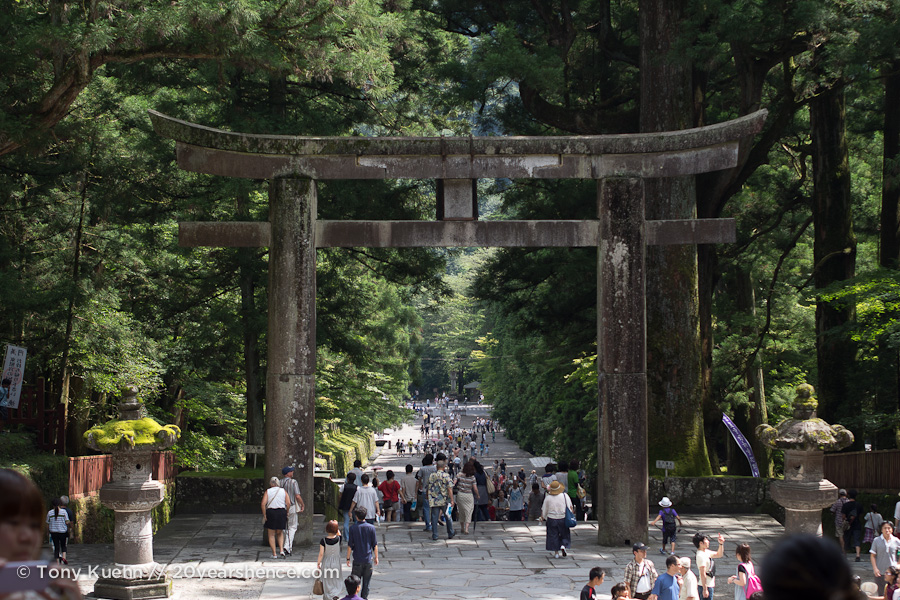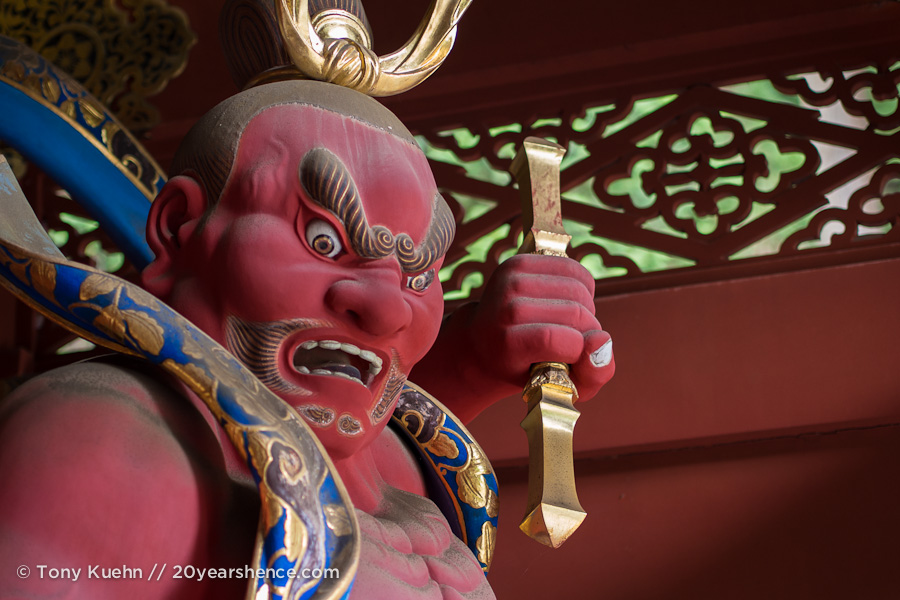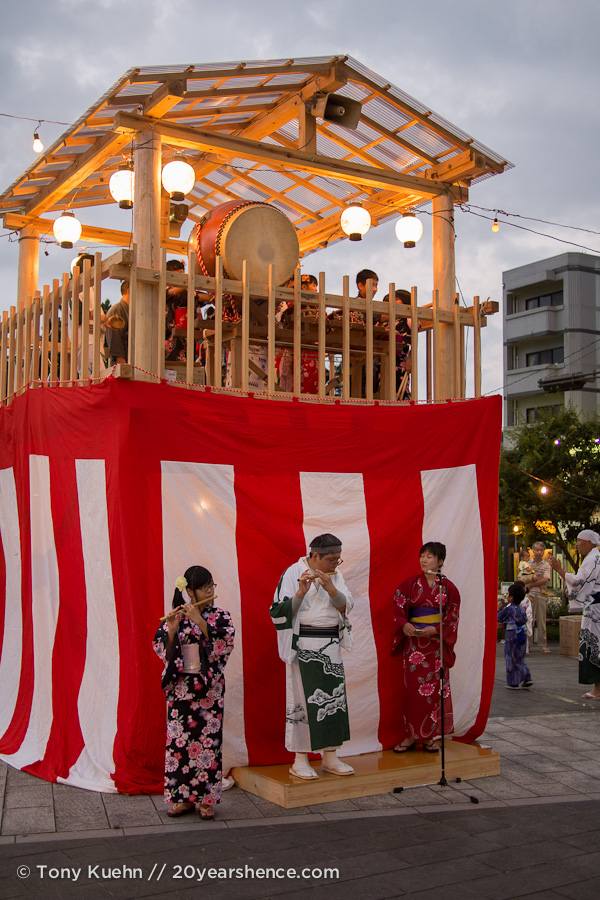Nikko is a small city in the mountains of central Japan. Serving as a gateway to the Nikko National Park and the UNESCO World Heritage Tokugawa Shogun Mausoleums, the city itself is little more than a trunk street with residential houses surrounding an elongated core of tourist shops and restaurants leading up a hill to the park and temples. This is not to say that Nikko lacks charm – quite the opposite! – but it is an easy town to see relatively quickly, which is good, as any visitor’s focus should rightly be on the park to the west of the city.

Our trip to Nikko began on a shinkansen (bullet train) out of Tokyo headed north to Utsonomiya, the capital of Nikko’s prefecture. After the success of the previous day’s trip to Kamakura, the thrill we felt at officially leaving Tokyo behind was palpable, but not so much that we could resist being lulled to sleep by the hum of the bullet train. Upon reaching Utsonomiya, we transferred to the much quainter Nikko Line. A two-car train, the Nikko Line exists solely to ferry visitors to and from the city nestled in the mountains. Filled with posters emblazoned with “Nikko is Nippon” and bearing a stencil of the famous “hear no evil, speak no evil, see no evil” monkey threesome Nikko is famous for, the little burgundy train waited patiently for its appointed time to trundle through backwoods and small farms and finally on to Nikko.
Our hostel was a short, 5-minute walk from the Nikko JR station, so dropping off our bags, we began the walk up to the park. We decided not to pay for the bus ride, as it was only a 20-minute walk to get to the park (and mercifully following our hike in Kamakura, the time estimate was accurate!). Nikko is small, filled mostly with smartly kept wooden houses and buildings in the traditional Japanese style. Nestled close together, with a little covered flume of water burbling down each side of the street, the houses exude tranquility and a collective mustiness that directly transported me to my grandmother’s basement and her massive collection of ancient National Geographic magazines. Probably somewhere in that collection is a picture that looks a lot like Nikko, and it felt strange and exhilarating to walk through something that was once so foreign and impossible.
Weather-wise, after the sultry closeness of Tokyo and the unrelenting heat and humidity of Kamakura, the slightly crisper air of Nikko was a welcome respite. However, as we would quickly learn, the lower temperature was no balm for the tremendous humidity that plagues Japan in the summer, leaving us clammy but not hot, a feeling akin to being sick with the flu.

Approaching the park on foot seems to be the least common method, but I think it is the best. The deep red of the Shin-kyo bridge greets you as you turn the last corner before the park, and the view is worth the walk. The rapids are swift and clear and the air is rich with the smell of cedar. As we walked up the hill to the temples the dampness increased, the moisture held in on all sides by the massive cedar trees.



After a short meander through residential streets surrounding the park, we found the massive parking lot for the temples and made our way up to the huge torii gate the leads to Tosho-gu, the most resplendent of the temples. Oddly there were two admission offices, though we didn’t notice this at first. The one on the left only sells tickets granting access to Tosho-gu AND the sculpture of the sleeping cat,for 1300Y, while the one on the right sells tickets that don’t include sleepy cat (but does grant admission to 4 other temples). After seeing a picture of sleepy cat, and some limited confusion dealing with the admission office staff of the left booth, we decided to save the yen and headed to the less obvious admission office on the right side of the gate and bought our cheaper 1000Y tickets, hoping that missing sleepy cat wouldn’t haunt us forever (spoiler: it didn’t).

Upon entering the grounds of Tosho-gu, we were staggered by the overwhelming ornamentation of the temple buildings. Inlaid with gold and covered in bright colors and endless sculptures, not a single inch is free from decoration of some sort. In fact, the buildings of Tosho-gu are so stunning that when they were constructed, one of the pillars of a gate was purposefully put in upside down so as not to offend the gods by this awesome display of beauty. And it is beautiful and astonishing, and, as our guidebook was quick to point out, so distinctly un-Japanese. No color, artifice or seemingly superficial element is off limits here. The general visual austerity common in Japan is thrown over for a riot of visual stimuli and the result is breathtaking.



Tosho-gu is a massive complex, and we spent easily over an hour wandering among the moss covered lanterns and the gilded buildings, soaking in the color amid the hordes of people. I’m glad we had the time to move slowly, because trying to navigate the crowds and gain any appreciation for the wonderful artifice of the buildings would have been impossible had we not been able to simply meander at a slow pace.

Once done with Tosho-gu, we headed to Yakushido to see the crying dragon. The massive drawing covers the ceiling of the interior room of the temple and is a testament to Japanese calligraphic drawing. I spent most of our time inside the temple simply absorbing the painting on the ceiling. Since visitors are not allowed to take photos, I wanted to be sure I appreciated the subtle mastery of the brushwork and coloration of the massive artwork. Though we didn’t know it at the time (since we speak little to no Japanese), the unique acoustics of the room create an interesting effect. When the monk claps two wooden sticks together anywhere in the room, the sound is deadened with little echo, but when the monk strikes them together under the dragon’s mouth, the dragon seems to “roar” and the sound echoes beautifully. Considering the room is rectangular and has no architectural features that would suggest a reason for this, it’s a neat illusion and illustrates a clever simplicity that is oh-so Japanese.

After Yakushido, we visited Futarasan-jinja and Taiyuin-Bo, which were perched on a hill among towering cedar trees. The latter was certainly our favorite temple of the day. Nestled among the massive cedars, and gently caressed by breezes from higher up the mountain, this smaller version of Tosho-gu had a tranquility and stillness that the other temples lacked. Perhaps because it is set slightly apart from the most popular areas and gets less traffic, we were better able to appreciate the temple itself. Imagining what this temple must have been like hundreds of years ago, free from crowds and lines and pickets, it was easy to feel transported to another time, when the gentle splash of water and the wind in the cedars were the only distractions.



Our last temple of the day was Rinnoji, which was honestly a bit of a disappointment. The temple is undergoing significant restoration, and as such is completely housed in a giant metal building. It’s a shame we had to see it like this, as I think the temple would be quite impressive if it weren’t swaddled in metal sheeting and scaffolds. The temple contains three giant wooden Buddha statues (the largest in Japan), which were also in various states of repair, and as such were in pieces and difficult to fully appreciate. It’s a shame that we came to this temple at such an inopportune time, as I think in some way seeing this process sort of diminished the experience. Intuitively I know that a wooden building is unlikely to survive for hundreds of years without extensive maintenance and rebuilding in a humid climate that experiences all four seasons, but seeing the process, seeing the sausage get made (so to speak), removes just a bit of the magic.


After a full day of temple viewing we decided to pack it in and head back down the mountain to doff our day packs and find some dinner. Leaving our hostel, we passed through Nikko’s charmingly sparse Obon celebration taking place in the town square near the bus station. The few locals participating seemed to be having a good time, in spite of the best efforts of three very bad flute players leading the band. There was some food on offer, but we decided to soldier on and head for a little restaurant we had read about earlier that seemed promising.
We headed out for dinner around 6:30, which we soon learned was far too late for respectable people to try to get a meal in Nikko. The first restaurant claimed to be completely out of food, which, while astonishing, meant we had to keep moving. After power walking nearly the entire length of the city to get to our first choice, we were a little worn out and very hungry, so our dinner journey became one of last resort. By this time we were noticing that nearly everything in Nikko was closed, and looked as though it had been for some time. The second restaurant we tried also claimed to be out of food. Amazing! This was either very poor planning, or very exact planning, depending on how you look at it, but in any case it left us little choice but to move on. Would we end up eating questionable Obon food off a stick while listening to remarkably bad flute playing? Fortunately not, as we finally found a place that was open and had food, which was good enough for us. The menu was sparsely populated with some images and no English, but the prices were legible so we took our chances. The cuisine appeared to be mostly centered on Italian dishes, which was an unexpected choice for a tiny city in the middle of nowhere in Japan, however we decided to try two of their few Japanese dishes.



The portions were huge and Steph picked a soup that she thought had yuba (tofu skin) in it, a regional speciality, which ended up being delicious. The meal was surprisingly tasty given that it was a last resort, but we commited this lesson to heart: if you are eating out in Japan outside of a major city, it’s best to do it early (pre-7pm) if you want to eat at all.
All in all, Nikko is a charming little town and its temples are nothing short of remarkable, so we’re happy that we squeezed in a day here. It’s a short train ride from Tokyo, and could even be a slightly compressed daytrip if the temples are all you are interested in, so if you are in that part of Japan there really is no excuse to miss it. Of course, beyond the temples, the national park itself is a large draw for those of the outdoorsy persuasion who enjoy hiking, camping, and waterfalls. Those aren’t the experiences we were interested in having, so a day was sufficient for our needs.
Continuing in the vein of our trip to Kamakura, the Japan we witnessed in Nikko was very different from the impression Tokyo gave us. Bucolic towns where people lead their lives with peace and friendliness are definitely Japan’s bread and butter (or perhaps, pickles and ginger?), the added bonus being that nearly every town has a history stretching back hundreds of years or more. Japan’s vibrant, and at times turbulent, history ensures that no matter where you are there is usually something interesting to see if you know where to look. With the UNESCO seal of approval, you can rest assured that Nikko has history in spades, guaranteeing that you won’t have to look very hard at all to find something wonderful. Although Japan is a country in which there is no shortage of temples, those found at Nikko are quite unlike any others that we saw and were just so stunning it’s safe to say that you haven’t fully sampled the temples of Japan until you’ve seen the ones in Nikko!
Nikko truly is unique. It also seems so much busier than I went. I went only 6 weeks after the Tsunami, so Japan was still mourning and empty. It looks a different place with the amount of people there, but it’s still breathtaking!
Check out these – http://www.flickr.com/photos/marcofiori/sets/72157626656941713/with/5763119820/ – you can see the difference in crowds (especially with the large Tori shot.
Yeah, it was super crazy, so many people and so humid. I would have loved to see it with fewer bodies crushed into the space! And thanks, it’s an easy subject to take beautiful pictures of, so that helps… But I must say, some of these are the work of Steph, she’s really hitting her stride as a burgeoning photographer, she has a good eye!
Looks gorgeous you guys – and amazing photos as always! I can’t believe a restaurant can ‘run out of food’ ha ha.. crazy.
Yeah, still not sure what to think there, I don’t know how they couldn’t make anything at all, it seems like there must have been something else at work, but I have no idea what it was…
Beautiful photos! Although that red dude looks quite fierce.
Thanks! I can’t take credit for all of them though… My wife has quite an eye!
Nikko seems so very beautiful!! I missed the place as I went to Nara and Kyoto which were both very beautiful too!! Japan is truly an amazing place. Your photos give me a feel as if I am travelling with you.
Have a Happy Sunday 🙂
Those are both very good destinations though! You’re right, Nikko is beautiful and seemingly unique. If you ever get back to Japan, I hope you get the chance to go!
Great post, Japan is such an amazing country! It’s so fun to read your posts now that you’ve hit the road! Tony, your professional photography background really shines in your wonderful photos. I look forward to hearing more about your time in Japan!
Thanks so much, and don’t worry, there is plenty more to come! I took a paltry 2000 photos during our week in Kyoto, and we have only barely made it out of Tokyo on the blog!
Tony, the quality of the photography has been fantastic. I don’t know if it has been the photographer or the camera 🙂 In any case, you are collecting quite a portfolio of images. Enjoy your time exploring together.
Thanks Rick! I’m sure my camera choice hasn’t hurt! Getting back in to photography has been exciting, and I am really starting to enjoy it again, the way I used to ages ago. I like to think that is showing in my shots.
Great photos of the place. You have captured the soul of the place quite beautifully.